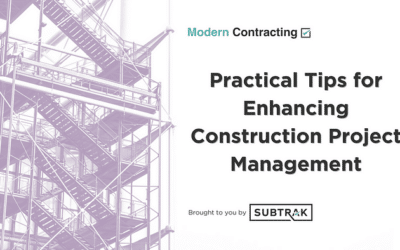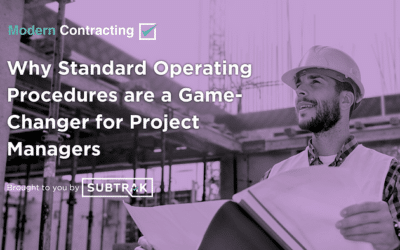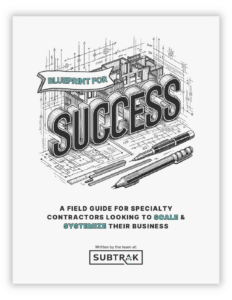For specialty contractors looking to systemize their business, creating standardized project timelines for each project type is foundational to communicating the company’s unique processes to its team. This article will dive deep into how specialty contractors can develop a well-structured project timeline, with construction phases are bookended by sequential project milestones. By the end, you’ll have a clear understanding of how your company can create customized project timelines for any project type.
Understanding the Importance of Project Timelines
Before we delve into the nitty-gritty of creating project timelines, let’s discuss why they are essential. Project timelines serve as a roadmap, guiding you and your team through each phase of the construction project. When projects are broken down into smaller achievable phases, tasks can be more coherently organized and job progress can be more easily measured. Having defined project timelines is not only vital for successful project management but is also the first step in any company’s documentation process with the ultimate goal of true business systemization.
Construction Phases and Sequential Milestones
The heart of effective project timeline creation lies in understanding that construction phases are bookended by sequential project milestones. Imagine a project timeline as a series of interconnected milestones and phases that dictate the flow of the project. When a project milestone is achieved, one phase ends and another begins. Take, for example, the milestone of Contract Signature Date. Generally, the day a contract is signed ends the Sales Phase and starts the Pre-construction Phase of a project. There are usually a handful of these key milestone moments that occur regularly throughout the lifecycle of a project and other projects of that same project type.
Creating Your Own Project Timeline
Now, let’s discuss how you can create your own project timeline by finding the right milestones and tasks for your projects:
- Define Your Project’s Phases: Begin by breaking down your project into these distinct phases — Sales, Pre-Construction, Construction, Punch List, and Closeout are common phases of many project types.
- Identify Critical Milestones: For each phase, identify the critical starting and ending milestones that bookend each phase. These are the key events that must happen for the project to progress. For instance, in the Pre-construction Phase phase, your ending milestone might be the Site Mobilization Date.
- List Tasks and Activities: Beneath each milestone, list the tasks and activities that need to be completed to reach that milestone. These are the smaller steps that contribute to the bigger picture.
- Establish Dependencies: Understand the dependencies between tasks. Some tasks must be completed before others can begin. This forms the logical sequence of your project.
- Set Durations: Assign estimated timeframes to each task, indicating how long it will take to complete. This allows you to create a realistic schedule.
- Connect the Dots: Using project management software or tools like Subtrak, connect the milestones, tasks, and durations to create a sequential timeline representing your entire project.

Example of a Construction Project Timeline
To better illustrate these concepts, let’s consider the following example of a typical project timeline that a specialty contractor might use on a commercial or residential construction project:
Sales Phase:
The Sales Phase marks the initial stage of a specialty construction project, where your primary goal is to define the project scope and secure a client’s commitment. Key milestones and activities in this phase include:
Initial Milestone: Lead Discovery Date
- Client Qualification: Qualifying potential clients who require your company’s services.
- Needs Assessment: Meeting with clients to understand their requirements, preferences, and goals.
- Proposal Development: Preparing detailed project proposals, including cost estimates and timelines.
- Client Agreement: Securing a signed agreement from the client, formalizing the project.
Ending Milestone: Contract Signature Date
Pre-Construction Phase:
This phase occurs after securing the client agreement and is focused on meticulous planning and preparation. Key milestones and activities in this phase include:
Initial Milestone: Contract Signature Date
- Scope Finalization: Refining the project scope, including specifications, designs, and materials.
- Permitting and Approvals: Acquiring necessary permits, licenses, and approvals from local authorities.
- Resource Allocation: Allocating resources, including materials, equipment, and labor.
- Budgeting: Developing a comprehensive project budget, which includes all costs.
- Schedule Development: Creating a detailed project schedule outlining tasks, milestones, and timelines.
- Procurement: Ordering and acquiring the necessary materials and equipment.
- Risk Assessment: Identifying potential risks and developing strategies to mitigate them.
Ending Milestone: Site Mobilization Date
Construction Phase:
The Construction Phase is the heart of the project, where you bring the project design to life. Key milestones and activities in this phase include:
Initial Milestone: Site Mobilization Date
- Site Preparation: Setting up the construction site, ensuring it meets safety standards.
- Task Execution: Executing the construction work as per the project schedule, including quality checks.
- Progress Monitoring: Continuously monitoring project progress and addressing any deviations.
- Quality Control: Ensuring that work adheres to quality standards and specifications.
- Safety Compliance: Maintaining a safe working environment and ensuring compliance with safety regulations.
- Client Communication: Regularly updating the client on project progress and addressing any concerns.
Ending Milestone: Substantial Completion Date
Punch List Phase:
The Punch List Phase occurs as the project nears completion and focuses on resolving any outstanding issues. Key milestones and activities in this phase include:
Initial Milestone: Substantial Completion Date
- Final Inspections: Conducting comprehensive inspections to identify any defects or incomplete work.
- Punch List Creation: Compiling a list of remaining tasks or issues that need to be addressed.
- Task Completion: Resolving punch list items, ensuring all work meets quality standards.
- Client Walkthrough: Inviting the client for a final walkthrough to review the project.
- Documentation: Creating as-built documentation, including plans, specifications, and warranties.
- Quality Assurance: Ensuring that all work meets quality and safety standards.
Ending Milestone: Final Completion Date
Closeout Phase:
The Closeout Phase is the final chapter of the project, involving activities to hand over the completed project to the client. Key milestones and activities in this phase include:
Initial Milestone: Final Completion Date
- Client Handover: Officially transferring the project to the client’s ownership.
- Documentation Submission: Providing all project documentation, including manuals, warranties, and as-built drawings.
- Project Evaluation: Conducting a post-project evaluation to assess what went well and areas for improvement.
- Client Satisfaction: Obtaining client feedback and addressing any remaining concerns.
- Demobilization: Dismantling the construction site and returning rented equipment.
- Project Closure: Officially closing out the project, including archiving project files and records.
- Final Payments: Receiving the final payments from the client and settling all financial matters.
Ending Milestone: Final Payment Received Date
Conclusion
Defining project timelines for each of your company’s project types is an important first step towards process documentation for specialty contractors. Understanding how construction phases align with sequential project milestones is the foundation of this process. Taking the time to define your project timelines for each project type will allow you to communicate your systems to your team within an easy-to-understand framework. But what makes this approach truly transformative is the ability to communicate and implement it effectively.
If your goal is to systemize your construction business in this way, a software solution like Subtrak can be an invaluable asset for small and mid-sized contractors looking to systemize their business. Subtrak provides the structure and guidance necessary to create and manage project timelines efficiently. Combined with automatic delegation of tasks and Standard Operating Procedures (SOPs), Subtrak simplifies the documentation process and ensures your team efficiently progresses through each project phase.
Furthermore, Subtrak enables digital management of each task within your timelines, making them accessible from anywhere and minimizing the risk of manual errors. Incorporating Subtrak into your business operations can be the catalyst that takes your specialty construction projects to the next level, allowing you to focus on what truly matters — delivering successful and timely projects.





